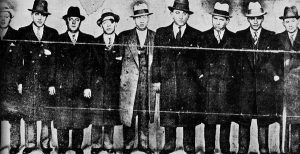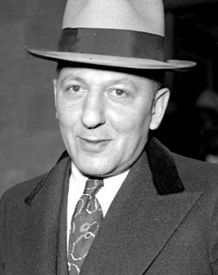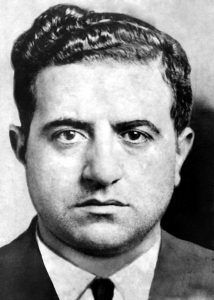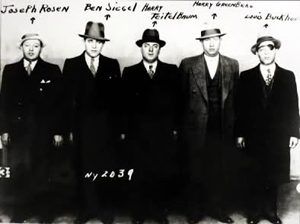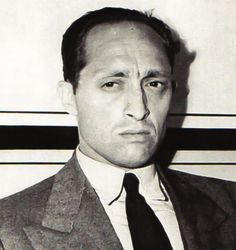By Joseph Bruno
After the Castellammarese War ended in 1931, with both opposing bosses, Joe “The Boss” Masseria and Salvatore Maranzano, ending up quite dead due to the treachery of Lucky Luciano, amongst others, Luciano, along with Jewish mobster mastermind Meyer Lansky, formed a nine-member National Crime Commission, which cut across ethnic lines. There was no single boss of this commission, but instead, the leadership was divided equally amongst Luciano, Lansky, Lansky’s sidekick Benjamin “Bugsy” Siegel, Frank Costello, Joe Bonanno, Vincent Mangano, Joe “Adonis “Doto, Louis “Lepke” Buchalter, and his right-hand man Jacob “Gurrah” Shapiro. (Loose cannon Dutch Schultz – real name Arthur Flegenheimer – was not a Commission member for precisely that reason: he was a loose cannon and could not be trusted with making common-sense decisions.)
Of course, all corporations need a separation of powers within that corporation, whereas certain people are given duties that do not infringe on the power and duties of other members of that organization. (Make no mistake, the National Crime Commission ran like a well-oiled machine and indeed operated like an unregistered corporation)
This is where Murder Incorporated came into play.
It was decided that sometimes distasteful things must be done to keep the Commission nice and profitable for the good of the National Crime Commission. This included killing people who endangered cash flow into the Commission’s coffers. The Commission decided that they needed to establish a separate branch of the Commission responsible for one thing and one thing only: the murder of those people the bosses said needed to be killed.
Louis “Lepke” Buchalter was in charge of what the press called Murder Inc. To assist Lepke in his duties, the Commission appointed Albert Anastasia, nicknamed “The Lord High Executioner,” as Lepke’s right-hand man. Lepke would never give a direct order to any of his killers to do a job. Instead, Lepke used trusted men like Mendy Weiss and Louis Capone to issue the final order and decree to the hitmen chosen.
By keeping a level or two of insulation between himself and the actual killers, Lepke figured nothing could ever be directly pinned on him.
And at first, Lepke was right until he made one fatal mistake.
Lepke and Anastasia’s first order of business was to assemble a crack-hit team to do the dirty work. Through Louis Capone, who was close to Anastasia, Lepke had been nurturing a group of homicidal maniacs, some of whom would rather kill than breathe the cool fresh air of Brooklyn. These killers were called “The Boys from Brownsville.” The Boys from Brownsville were hardly the only killers employed by Murder Inc., but they were the foundation that led to as many as 100 freelance assassins being put on a steady weekly salary (of $125 and up) to be ready to kill whenever an order was given. These men were sometimes paid extra for a job exceptionally well done. They were allowed to operate in designated territories in the gambling and loansharking businesses or any illegal operation, like hijackings and even kidnappings. But one thing is for sure: even if a member of Murder Inc. didn’t kill anyone for a month, or two, or three, his killing salary came in steadily every week.
Now let’s get to the cast of characters of Murder Inc.
The first and foremost was the biggest headache for Lepke: Abe “Kid Twist” Rules. By eliminating the three Shapiro brothers, Meyer, Irving, and Willie, Reles and his childhood pal Martin “Buggsy” Goldstein took over all the illegal rackets in the Brownsville section of Brooklyn. To do so, Reles enlisted the help of Harry “Happy” Maione and Frank “Dasher ” Abbandando of the neighboring “Ocean Hill Hooligans.” Soon, cutthroat killers like Harry “Pittsburgh Phil” Strauss, Vito Gurino, and “Blue Jaw” Magoon were taken into the fold, and the Boys from Brownsville were a formidable group of killers. The key for their transition from Brownsville to the big time was Louis Capone, ostensibly a Brooklyn restaurateur who was very close to Albert Anastasia.
When Anastasia, along with Lepke, was entrusted by the Commission to form Murder Inc., Anastasia approached Capone and said, “What about Reles and his boys from Brownsville? Are these guys capable of doing what needs to be done? No questions asked.”
Capone assured Anastasia that Reles and his boys were stone-cold killers and efficient ones at that. Capone’s only problem was that Reles and Maione considered the group’s number one and number two leaders, hated each other’s guts, and they didn’t trust each other much either.
Despite their petty differences, Reles and Maione worked like a well-oiled killing machine. Under Anastasia and Capone’s direction, the Murder Inc. killers operated in an almost foolproof manner. When the bosses gave out assignments for killings all over the country, the arrangements made to detect the actual killers were almost impossible. The key to their method was the concepts of corroboration and separation of powers. The bosses brought in several men to do different aspects of each job, with one man knowing nothing about the other men and their involvement. Still, each man was so intimately involved in the operation. He would be considered an accomplice, and his possible corroborating testimony was useless in a court of law if he ever decided to turn rat.
For instance, Joe Schmoe from Illinois was next on Murder Inc.’s hit list. Murder Inc. would hire one man to steal an automobile for the getaway. Then, another man would be directed to get as many guns as were needed for the job. Then there would be a third man, who would be the ‘finger-man”: the one who would point out Joe Schmoe to the actual shooters. Then, of course, they needed a getaway driver and a driver of a “crash car”: a legitimately registered car, that would crash into a pursuing police car, or the car of a nosy citizen, after the deed was done. The reason for the legit car was that the driver of the crash car could claim it was just an accident while the shooters escaped in the stolen car. (For obvious reasons, it was not a smart idea to crash into a police car with a stolen car.)
The beauty of this routine was that each man involved in the murder would have limited knowledge of the other men involved in the hit. The man who stole the car would not know who purchased the guns or who did the actual shooting, etc… etc…
Of course, Lepke and Anastasia did not rely entirely on the Boys from Brownsville to do all their dirty work. Other killers were needed to do a variety of jobs in a myriad of places. One killer was enlisted from an unlikely place: the Loch Sheldrake Country Club in the Catskills, in upstate New York.
The Loch Sheldrake Country Club was owned by Sam Tannenbaum, who had first owned a grocery store on Orchard Street on the Lower East Side of Manhattan. The Loch Sheldrake Country Club was a ritzy establishment that housed many rich Jewish families for their summer vacations. Of course, Lepke and his crew were well-represented at the Loch Sheldrake. Those gangsters who rubbed elbows with the legitimate Jewish businessmen included Lepke, his partner Jacob “Gurrah” Shapiro, Shimmy Salles, a bagman for Lepke’s rackets, Curly Holtz, a labor racketeer, and “Big Harry” Greenburg, who was Lepke and Shapiro’s partners in various Garment Center swindles.
Gurrah Shapiro, a thick-chested gorilla-of-a-man, was quite a character himself and also quite capable, as was Lepke, of pulling the trigger when necessary. Whenever Shapiro was angry, and that was often, his favorite saying was, “Get out of here.” Yet, with his gravelly voice, the phrase sounded like “Gurra dahere.” Hence, his pals gave Shapiro the nickname “Gurrah.”
Sam Tannenbaum had a teenage son named Allie, who Sam eventually was grooming as his replacement when Sam decided to retire. Sam Tannenbaum employed Allie at his hotel, either waiting tables or setting up beach chairs by the lake. Sam also did not pay Allie a dime for his work to ensure Allie didn’t disappear to his old haunts on the Lower East Side of Manhattan until after the summer season. As the owner’s son, the Jewish gangsters invited Allie Tannenbaum to all their parties, and Allie got a fresh taste of what it was like to be around people with coins constantly jingling in their pockets. This made him a likely suspect to be drawn into their world of murder and mayhem.
One day, after the summer season of 1931 was over at Loch Sheldrake, Tannenbaum was strolling down Broadway in Manhattan when he bumped into “Big Harry” Greenberg.
Greenberg asked Tannenbaum, “Do you want a job?”
“I could use one if it pays,” Tannenbaum said.
Greenberg smiled. “This one is for Lepke. You know what kind of a job it will be.”
Tannenbaum shrugged and said he would do whatever it took to earn some fancy cash to spread it around like his Jewish gangster idols.
Little did Greenberg know he was hiring one of his eventual killers.
Tannenbaum started working for Lepke, initially for $35 a week. His job included general assignments like slugging, strikebreaking, and throwing stink bombs where they needed to be thrown. He later graduated to more important duties, like “schlammings,” which meant he “schlammed,” or cracked the heads of union workers who were not towing Lepke’s line.
As his work production increased, so did Tannenbaum’s salary. In short order, he was intimately involved in six murders, and he helped dispose of the body of a seventh murder victim. As a result of “making his bones” in the murder department, Tannenbaum started raking in an impressive $125 a week, more than he made in an entire summer at his father’s resort. Because of his summer location in the Catskills, Tannenbaum’s job mainly consisted of murders and extortions in upstate New York. Tannenbaum was a valuable asset to Lepke in Sullivan County because he was familiar with the back highways and numerous lakes where bodies could be disposed of. During the winter, Tannenbaum and his family vacationed in Florida, where he worked as a strong-arm-man in several of Lepke’s gambling joints.
In the early 1930s, Lepke added another valuable asset to Murder Inc. when he hired Charlie “The Bug” Workman.
“The Bug” was born on the Lower East Side of Manhattan in 1908, the second of six children born to Samuel and Anna Workman. Workman quit school in the 9th grade and began roaming the Lower East Side streets, looking for trouble. When he was 18, Workman was arrested for the first time for stealing a $12 bundle of cotton thread from a truck parked on Broadway. Since it was his first offense, Workman got off with simple probation. The following year, Workman was arrested for shooting a man behind the ear over who-owed-who $20. By this time, Workman’s reputation on the streets was such that the man he shot refused to testify against him and even said he couldn’t truthfully identify Workman as the shooter. Miffed, the cops pulled up his file and decided Workman had violated his parole on the cotton theft. As a result, Workman was sent to the New York State Reformatory. For the next few years, Workman was in and out of prison for such parole violations as associating with “questionable characters” and “failure to get a job.”
In 1926, Workman hooked on as a freelance leg breaker, or schlammer, for Lepke’s union strike-breaking activities. Workman did such a good job; in the early 1930s, Lepke put Workman on his permanent payroll at $125 a week as a killer for Lepke’s Murder Incorporated machine. Lepke liked Workman’s cool demeanor, and after Workman performed a few exceptional “hits” for Lepke, Lepke gave him the nickname “The Bug” because a person had to be crazy to kill with the calm detachment Workman displayed when performing his gruesome tasks. Workman’s other nickname, “Handsome Charlie,” was given to him by members of the opposite sex.
For the next few years, Workman was in and out of trouble with the law. In 1932, he was arrested for carrying a concealed weapon. In 1933, Workman was arrested again for decking an off-duty police officer after a minor traffic dust-up. All the while, his specialty was killing whomever Lepke said needed to be killed. After a hit was done, Workman enjoyed the fringe benefit of “sweeping out the pockets” of his victims. Most of the time, Workman earned himself an extra thousand dollars or so for his efforts. And one time, he even found a ten-thousand-dollar bonus in the pants pocket of some poor sucker whom he had just whacked.
Lepke’s Murder Inc. didn’t limit its exploits to the New York City area. In fact, Murder Incorporated eventually employed anywhere from 150-200 killers around America, and it was reported these killers may have committed as many as 800-1000 murders from the late 1920s until Murder Incorporated’s demise in the early 1940s.
About the Author: A Vietnam veteran in the United States Navy, Joseph J. Bruno started in the newspaper business in the mid-1970s as a sports columnist for the New York Tribune. During the 1970s and ’80s, Bruno was an associate editor for Boxing Illustrated and a monthly contributor to Ring Magazine. In 1986-1987, Bruno wrote a sports column for the Times Herald-Record in Middletown, New York. Since then, he has written numerous articles for various magazines and books — both fiction and non-fiction. More information can be seen on his blog here: John Bruno on the Mob. Source: Ezine Articles (dead link.)
Compiled by Kathy Alexander/Legends of America, updated January 2024.
Also See:
Gangsters of the Prohibition & Depression Era
Speakeasies of the Prohibition Era

